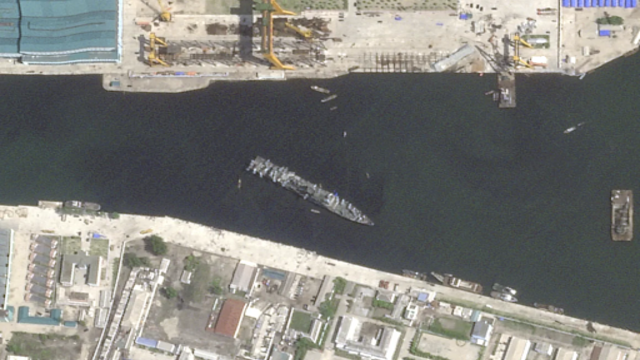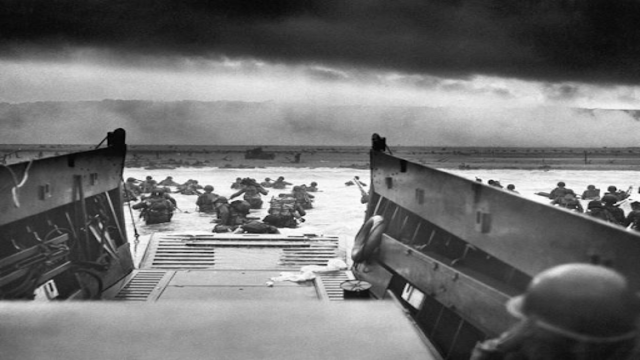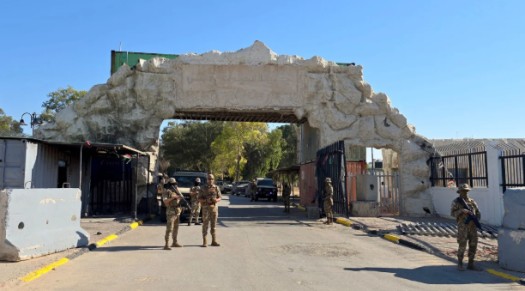
This satellite image shows a re-floated North Korean destroyer after it suffered a failed launch while being put to sea in Chongjin, North Korea, on Thursday.
North Korea has stunned global military analysts by refloating a newly built destroyer that dramatically capsized during its initial launch last month. This unexpected recovery is being hailed by Pyongyang as a testament to the country’s commitment to naval advancement.
On June 5, satellite images from Planet Labs confirmed the destroyer, previously stuck and partially submerged, was now upright and floating away from the launch pier in Chongjin.
A Major Setback Turned Into a Quick Recovery
The 5,000-ton destroyer—North Korea’s latest and most ambitious warship—was meant to signal a leap forward in its naval modernization program. However, during its sideways launch on May 21, a failure in the mechanism caused the stern to slip prematurely into the water, damaging the hull and leaving the bow stranded on dry land.
The incident, witnessed by Kim Jong Un himself, drew harsh internal criticism. Kim labeled the accident a “criminal act” and ordered immediate arrests of four individuals allegedly responsible.
Despite the disastrous start, North Korean state media was quick to claim that the damage was “less severe than feared.” Kim then issued a directive to repair the vessel before the late-June plenary meeting of the Workers’ Party, framing the restoration as a matter of national pride.
Maxar imagery shows continued efforts to conceal the damaged destroyer at Hambuk Shipyard one day after the failed launch.
Innovative Techniques Surprise Experts
Experts worldwide were skeptical about North Korea’s ability to salvage the vessel so quickly. Many believed the damage would require months of work, or even result in the scrapping of the ship.
But North Korea proved them wrong.
Using what analysts now believe to be aerostatic balloons, technicians managed to stabilize and refloat the destroyer within two weeks. Satellite imagery appeared to confirm the use of large air balloons attached to the hull, helping to balance and lift the ship.
Carl Schuster, a former US Navy captain, expressed surprise:
“Sheer manpower and – let’s face it – an innovative approach to righting the ship, delivered a solution in two weeks that people like me didn’t expect for four to six.”
A Race Against the Clock: Repairs in Rajin
According to the Korean Central News Agency (KCNA), the ship has been safely moored and will soon be transported to the Rajin Dockyard. There, it will undergo an intensive 7- to 10-day dry dock repair program.
Jo Chun Ryong, Secretary of the Central Committee and head of the repair mission, assured that the “perfect restoration” of the warship will be completed in time for the upcoming political meeting.
The repair process will involve cleaning and drying the ship’s internal compartments, purging machinery of seawater, and restoring any electronic systems that were damaged.
Schuster noted that the biggest challenge now lies beneath the surface:
“Nearly everything is doable if you are willing to commit the resources and have the human talent to employ it.”
What This Means for North Korea’s Naval Goals
This rapid turnaround demonstrates North Korea’s resolve to modernize its naval forces, even under immense pressure and scrutiny. The ability to bounce back from such a technical and symbolic failure not only boosts national morale but sends a message to the world about its determination and capability.
While the destroyer remains unnamed and untested at sea, its recovery marks a major moment in North Korea's naval ambitions. Whether the vessel performs as intended remains to be seen, but the urgency and ingenuity displayed during this crisis have already shifted analysts’ expectations.















